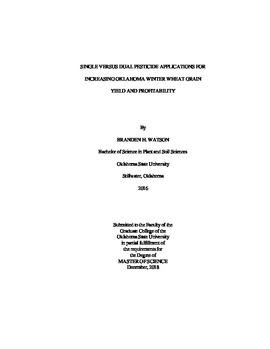| dc.contributor.advisor | Edwards, Jeff | |
| dc.contributor.author | Watson, Branden H. | |
| dc.date.accessioned | 2019-07-19T14:49:26Z | |
| dc.date.available | 2019-07-19T14:49:26Z | |
| dc.date.issued | 2018-12-01 | |
| dc.identifier.uri | https://hdl.handle.net/11244/321004 | |
| dc.description.abstract | Foliar fungicides and insecticides can be useful tools in management decisions against fungal diseases and insect pests of winter wheat in Oklahoma, but little is known about multiple applications and tank-mixes of these pesticides. Two studies were conducted across three different locations during the 2016-2017 and 2017-2018 growing seasons, focusing on multiple fungicide treatments and fungicide + insecticide treatments at two different timings, Feekes 6 (jointing) and Feekes 9 (full flag leaf emergence). Two wheat varieties were used in each study, chosen based on susceptibility and resistance to fungal diseases. In the first study which assessed a dual fungicide application approach compared to a single application, results showed that a dual fungicide application can reduce disease levels, protect more yield potential, and provide greater marginal return than a single fungicide application. However, this management practice was highly dependent on variety and location. Due to the timing of disease occurrence in most cases during the course of the study, a single fungicide application was more often profitable than the dual application approach. The second study examined the effect of fungicide + insecticide tank-mix applications compared to each pesticide applied alone at both growth stages. Results for this study showed that a fungicide + insecticide application can provide greater yield than each pesticide applied alone. However, this result was highly dependent on the year, location, and timing when fungal diseases and/or insects were present, and it only occurred at the Feekes 6 application timing. Greater marginal return from a fungicide + insecticide application compared to each pesticide applied alone was also dependent on year and location. This greater marginal return from the fungicide + insecticide application was observed at both Feekes 6 and Feekes 9 but occurred at the Feekes 6 application timing the majority of the time. Based on the results of these two studies, scouting for fungal diseases and insects and understanding wheat variety susceptibility to fungal diseases should dictate whether multiple fungicide applications and/or fungicide + insecticide tank-mixes should be used instead of making prophylactic applications in Oklahoma. | |
| dc.format | application/pdf | |
| dc.language | en_US | |
| dc.rights | Copyright is held by the author who has granted the Oklahoma State University Library the non-exclusive right to share this material in its institutional repository. Contact Digital Library Services at lib-dls@okstate.edu or 405-744-9161 for the permission policy on the use, reproduction or distribution of this material. | |
| dc.title | Single Versus Dual Pesticide Applications for Increasing Oklahoma Winter Wheat Grain Yield and Profitability | |
| dc.contributor.committeeMember | Hunger, Robert Marvin | |
| dc.contributor.committeeMember | Royer, Tom | |
| dc.contributor.committeeMember | Marburger, David A. | |
| osu.filename | Watson_okstate_0664M_16013.pdf | |
| osu.accesstype | Open Access | |
| dc.description.department | Plant and Soil Sciences | |
| dc.type.genre | Thesis | |
| dc.type.material | Text | |
